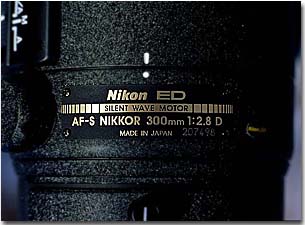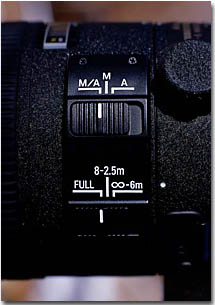|
|
 Camera Equipment Review... 300/2.8 AF-S Nikkor
Text and Photography Copyright Larry Castiglia
For years, Nikon has been known as the professionals’ choice because of their nearly indestructible “F” bodies and incredible optics. Their slogan “We take the world’s greatest pictures” is a proven fact with more professionals using Nikon than any other brand. One of their most prized lenses among pros is the popular 300mm/2.8 Nikkor. This lens has been a favorite of pros and amateurs alike for over thirty years. The AF version of this lens is currently in its fourth generation, the second of which has an integral focusing motor. The current AF-S lens (which supercedes the earlier AF-I version) with its “Silent Wave” focusing motor offers the highest automatic focus tracking performance available, up to eight frames per second with the F5 body. The lens is supplied with the CL-300 lens case (the CT-505 trunk case is now an option), strap, gelatin filter holder and front & rear lens caps. The lens has a very elegant look, finished in Nikon’s black crinkle paint that is typical of all their big ED glass and uses a carbon fiber lens hood for reduced weight. The new series of AF-S lenses also sport built-in protection filters over the front lens element. This is a welcome addition to the new line of lenses as big glass Nikon users all know the cost of the 112mm L37C filter that used to be an accessory for the older 300/2.8’s.
Field-testing this lens was an absolute joy! Mounting the lens on an F5 body and then locking it on the tripod’s ball head, I noticed right away how well balanced the camera and lens was. Pointing the lens at an object 20-ft. away, the subject jumped into sharp focus as the background was reduced to a beautiful blur. The lens uses nine diaphragm blades that Nikon states give more natural, out-of-focus effects. The lens performs well at maximum aperture, although stopping it down to 5.6 seems to yield its best sharpness. Nikon also has two tele-converters designed to operate exclusively with AF-I and AF-S lenses, the TC-14E and the TC-20E. The TC-14E extends the focal length of the prime lens by a factor of 1.4, while the TC-20E extends by a factor of 2 the original focal length. The TC-14E reduces the effective maximum aperture by one stop, while TC-20E reduces it by two f-stops. The use of these two tele-converters in combination with the 300mm/2.8 AF-S can give the nature or sports photographer the ultimate in versatility at a very affordable price. The 300mm/2.8 coupled with TC-14E results in a 420mm/4.0 super telephoto and when combining the 300mm/2.8 with the TC-20E, a monster 600mm/5.6D AF-S ED Nikkor is at your disposal. The Tele-converters sell for about $550.00 each, a mere fraction of what a 400 or 600mm lens would cost and provide outstanding optical performance. So, if you’ve considered this lens at any time and were not sure if it’s worth the money, take it from me, once you’ve used it you’ll be hooked on it forever. LC-NPN |
|
|
 Lens Construction (groups/elements): 8/11
Lens Construction (groups/elements): 8/11 Mount the lens on a compatible body (F5, F4s, F100, N90, N90s, N80, N70, Pronea 6i or D1 digital), touch the shutter release lightly and you will notice that focusing is fast and nearly silent, much like Canon’s Ultrasonic Motor Lenses. There are three focusing modes available via the M/A-M-A switch on the side of the lens barrel. In the M/A position, the lens autofocuses with “on command” manual focus override without flipping a switch, allowing you to touch up the focus at any time. In the M position, the lens gives you full time manual focus with no autofocus capability at all. In the A position the lens is in full time autofocus only, with no manual override. Most users will find that the M/A position the most useful. Below the AF mode selector on the barrel is a three-position focus range selector switch marked FULL, 8-2.5m, and infinity to 6m. Selecting the camera-to-subject distance range in which you will be working allows the lens to focus faster. The FULL position allows focusing within the full range of the lens, 2.5 meters to infinity. Four AF lock buttons are conveniently located toward the front of the barrel, spaced at 90-degree intervals. These buttons allow locking the focus at any time when track focusing a subject. The lens has a built-in tripod collar and uses 52mm drop-in filters, making filter selection greater and less costly than on the previous AF-I series of lenses, which used 39mm drop-in filters.
Mount the lens on a compatible body (F5, F4s, F100, N90, N90s, N80, N70, Pronea 6i or D1 digital), touch the shutter release lightly and you will notice that focusing is fast and nearly silent, much like Canon’s Ultrasonic Motor Lenses. There are three focusing modes available via the M/A-M-A switch on the side of the lens barrel. In the M/A position, the lens autofocuses with “on command” manual focus override without flipping a switch, allowing you to touch up the focus at any time. In the M position, the lens gives you full time manual focus with no autofocus capability at all. In the A position the lens is in full time autofocus only, with no manual override. Most users will find that the M/A position the most useful. Below the AF mode selector on the barrel is a three-position focus range selector switch marked FULL, 8-2.5m, and infinity to 6m. Selecting the camera-to-subject distance range in which you will be working allows the lens to focus faster. The FULL position allows focusing within the full range of the lens, 2.5 meters to infinity. Four AF lock buttons are conveniently located toward the front of the barrel, spaced at 90-degree intervals. These buttons allow locking the focus at any time when track focusing a subject. The lens has a built-in tripod collar and uses 52mm drop-in filters, making filter selection greater and less costly than on the previous AF-I series of lenses, which used 39mm drop-in filters.